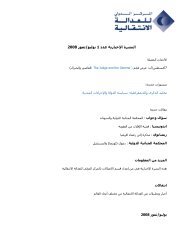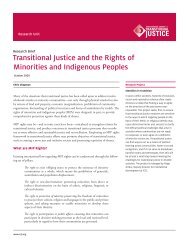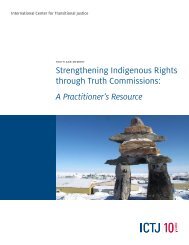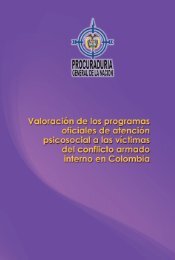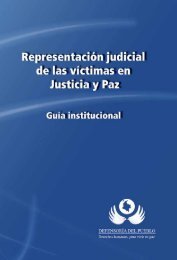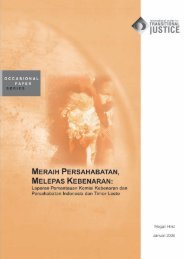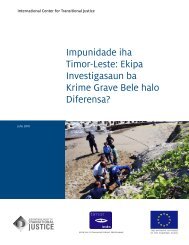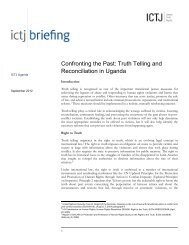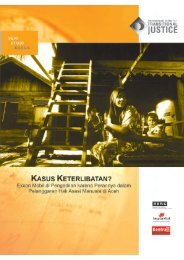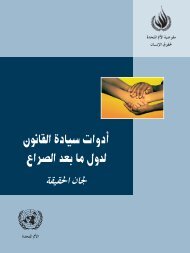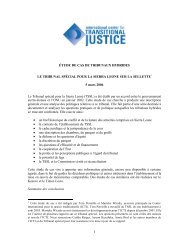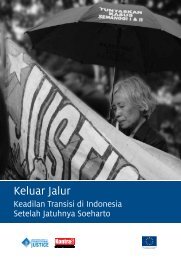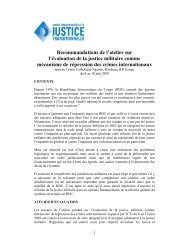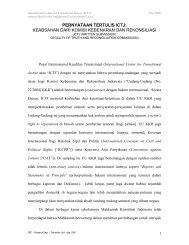That Someone Guilty Be Punished - International Center for ...
That Someone Guilty Be Punished - International Center for ...
That Someone Guilty Be Punished - International Center for ...
You also want an ePaper? Increase the reach of your titles
YUMPU automatically turns print PDFs into web optimized ePapers that Google loves.
Women [who were captured by Serb soldiers] were kept in various houses, apartments,<br />
gymnasiums or schools. Even prior to their being brought to those detention centres,<br />
some witnesses who testified be<strong>for</strong>e the Trial Chamber said that they had been physically<br />
abused or raped by the soldiers who had captured them. Thus, FWS-50, FWS-48,<br />
FWS-75 and FWS-87 stated that they were raped at Buk Bijela, a settlement south of<br />
Foča where they had been taken after their capture. FWS-75 was taken away from the<br />
group by a man of 40–50 years who proceeded to rape her. She was subsequently raped<br />
in this very same room by approximately 10 other men. She fainted after the tenth<br />
man. 118<br />
This was just the beginning of a months-long period of continuous gang rapes during<br />
what was legally judged to be the crime against humanity of enslavement and rape, essentially<br />
constituting what would now be regarded as sexual slavery had this crime been within the<br />
jurisdiction of the ICTY. The trial judgment provides a glimpse of what FWS-75 and other<br />
captives endured throughout this period in its account of a two-week period that was hardly<br />
unique: After spending a week in the apartment of one of the defendants in the Kunarac case,<br />
Radomir Kovač, FWS-75 and another captive, twelve-year old A.B., were taken to another apartment<br />
where “[t]he two girls stayed … <strong>for</strong> about 15 days, during which they were constantly<br />
raped by at least ten or fifteen Serb soldiers.” 119 Serb soldiers then took the girls to another<br />
apartment, where they stayed “<strong>for</strong> about 7-10 days, during which time they continued to be<br />
raped.” 120 Radomir Kovač ultimately sold 12-year-old A.B. and FWS-87 to two Montenegrin<br />
soldiers <strong>for</strong> 500 Deutschmarks each. 121<br />
On December 25, 1992, Kovač handed FWS-75 over to another soldier “in the almost<br />
certain knowledge that [she] would be raped again.” 122 By then, there were virtually no Bosniaks<br />
left in Foča, 51 percent of whose residents were Bosniaks in 1991. 123<br />
32 VICTIMS’ JUSTICE<br />
* * *<br />
Bosnia and Herzegovina is filled with individuals who survived harrowing crimes—and with<br />
the graves of those who did not. 124 No measure of justice can restore what victims have lost<br />
<strong>for</strong>ever, and many of the survivors we interviewed are acutely aware of this. For most survivors,<br />
moreover, specific crimes that <strong>for</strong>ever changed their lives are part of a broader canvas of enduring<br />
trauma, of deeply felt injustices that cannot be redeemed by criminal prosecutions—the<br />
haunting remembrance that it took years be<strong>for</strong>e the international community took action to<br />
end their suffering; the post-conflict division of their country under terms that Bosniak victims<br />
see as the rewarding and ratification of ethnic cleansing; the daily injustice of exile from<br />
homes in which generations of their families lived.<br />
But if trials cannot heal victims’ wounds, many “desperately need justice.” 125 Asta Zimbo,<br />
who worked with survivors’ groups on behalf of the <strong>International</strong> <strong>Center</strong> <strong>for</strong> Missing Persons,



